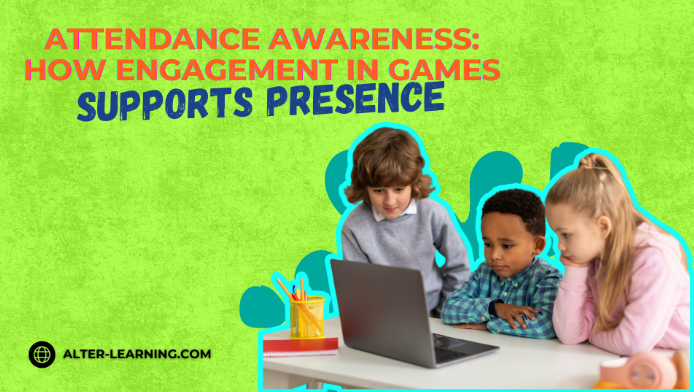Feedback is at the heart of all meaningful learning. When learners receive timely, actionable insights on their progress, they’re more likely to reflect, adjust, and persist. In traditional classrooms, this might come in the form of grades, comments, or peer discussion. But in game-based learning environments, feedback can take on entirely new—and often more engaging—forms.
Whether delivered as a visual cue, a score update, a narrative consequence, or a collaborative checkpoint, feedback in educational games can help students stay focused, motivated, and aware of their growth. At Alter-Learning, feedback is not just a feature—it’s a pedagogical strategy built into every challenge, simulation, and interactive experience.
Why Feedback Matters in Learning
Research in cognitive psychology and education consistently points to feedback as one of the most effective tools for improving learning outcomes. It helps learners:
- Understand what they’ve mastered and where they need improvement,
- Reinforce correct understanding and correct misconceptions,
- Stay motivated by tracking their own progress,
- Build metacognitive awareness by reflecting on choices and results.
In game-based learning, feedback isn’t limited to end-of-lesson evaluations—it’s embedded in the experience itself. It happens in real time, creating a loop of action, response, and reflection.
How Game-Based Feedback Can Enhance Learning
Interactive STEAM learning platforms like those from Alter-Learning use feedback to do more than just inform—they guide, encourage, and sometimes challenge. Here’s how feedback can be implemented effectively through educational games:
1. Immediate, Action-Oriented Feedback
One of the key advantages of digital games is the ability to offer instant feedback. When students make a decision or complete a task, they see the result right away.
- In math puzzle games, students can receive corrections or hints when an answer is off,
- In interactive physics simulations, visuals might shift to reflect the effects of force or motion,
- In virtual chemistry labs, a failed reaction may prompt a rethink rather than a penalty.
This instant response helps reinforce concepts while they’re still fresh, making learning both more engaging and more effective.
2. Feedback as Part of the Story
Games on the Alter-Learning platform often use narrative-driven feedback. Instead of a generic “Correct!” message, players see the impact of their choices unfold in the game world.
- A successful solution in a STEM challenge might lead to a restored system,
- Poor resource management might result in narrative setbacks—encouraging students to revise their approach,
- Characters within the game may provide coaching or encouragement, reinforcing emotional engagement.
By tying feedback into the storyline, learners feel the consequences of their decisions in a meaningful way.
3. Progress Tracking and Mastery-Based Systems
Another benefit of game-based learning is the ability to track progress visually and structurally. Many Alter-Learning environments include:
- Level-based progression systems, where each new challenge builds on previous ones,
- Badges, stars, or achievement markers that signal success,
- Feedback integrated into dashboards for students and teachers.
These systems help students self-monitor and take ownership of their learning journey—an important part of building autonomy and confidence.
4. Collaborative and Peer Feedback
In multiplayer or co-op games, feedback can also come from peers. This type of social feedback builds:
- Communication skills, as students negotiate, teach, and support one another,
- Team awareness, as each player contributes differently to shared goals,
- Reflection, as learners consider alternative approaches or solutions.
Alter-Learning’s platforms with multiplayer features often embed this kind of feedback into shared missions, encouraging collaborative learning alongside individual progress.
Teacher Insights Through Feedback Loops
For educators, feedback doesn’t end with the student. With the help of integrated analytics and teacher dashboards, game-based tools can offer:
- Insight into which concepts students struggle with most,
- Performance comparisons across groups or individuals,
- Opportunities to adjust instruction based on real-time learning patterns.
Teachers can use this data to refine lesson plans, target interventions, and personalize instruction—making their support more efficient and impactful.
Creating a Culture of Growth Through Games
One of the most powerful things feedback can do is reframe failure. In game-based learning, failure isn’t the end—it’s a clue. A puzzle not solved, a mission incomplete, a strategy that didn’t quite work—each is a starting point for improvement, not a source of shame.
By embedding feedback into the learning loop, Alter-Learning helps students:
- Learn resilience through repetition and experimentation,
- See mistakes as part of the process, not as roadblocks,
- Build a growth mindset that supports long-term academic and personal success.
Feedback That Moves Learning Forward
Feedback, when timely, meaningful, and personalized, can transform how students engage with content—and with themselves as learners. Educational games like those offered by Alter-Learning are uniquely positioned to provide this kind of feedback in dynamic, fun, and effective ways.
Whether through visual cues in a VR math game, narrative consequences in an environmental simulation, or achievement-based goals in a science game for kids, feedback is more than just a response. It’s a powerful engine for learning.
And when feedback feels like part of the journey—not just the score at the end—students may not only perform better. They may enjoy the process more, too.
Follow Alter-Learning for more insights into immersive education, edtech success stories, and the future of learning. Want to explore how VR/AR could transform your school or learning platform? Let’s connect.




